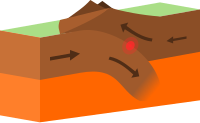
Photo from wikipedia
Abstract Deepwater fold-thrust belts (FTBs) are predominantly formed by the deformation of sedimentary sequences as a result of subduction of oceanic plates at active margins, gravitational failure at passive margins,… Click to show full abstract
Abstract Deepwater fold-thrust belts (FTBs) are predominantly formed by the deformation of sedimentary sequences as a result of subduction of oceanic plates at active margins, gravitational failure at passive margins, or a combination of these two driving mechanisms at both types of margin. A key question is: Is the FTB driven by gravitational failure basically the same as the FTB driven by plate convergence or are there fundamental differences? To address this, we reviewed FTB examples from different tectonic settings (end members and hybrid systems) in terms of geometry, structure, deformation, shortening rate, and tectonic process. The energy source in gravity-driven systems lies within the sedimentary material itself that is being deformed by updip extension and downdip contraction, whereas in the plate convergence-driven systems, it lies outside the local sediment pile and within the broader undeformed crust and lithosphere. The energy in gravity-driven systems is resupplied by sediment input from large river deltas and therefore deformation tends to be episodic, linked to episodes of major sediment input; whereas in a system driven by plate motions, the energy is resupplied by movement of a boundary upon which force is acting, and tends to be stable and less episodic. Therefore the sedimentation plays an important role in the gravity-driven deformation, but a less important role in the plate convergence-driven deformation. In gravity-driven systems, it promotes upward propagation of normal faulting at upslope by increasing maximum principal stress but hinders upward propagation of thrusting (i.e. mostly buried structures) by increasing minimum principal stress at downslope; while in plate convergence systems, thrusts and folds tend to deform seafloor as a result of large compression, with less effect from sedimentation. Despite the varying basal strength, the observed thrust faults in both systems are mostly basinward-verging, in slight contrast to the theoretical model predication (with homogeneous material), implicating the control of likely variability of stratigraphic strength on thrust vergence. The shortening rate across plate convergence-driven systems is high (several tens mm/yr), and continuous on a long timescale; whereas across the gravity-driven fold-thrust belts, it is generally slow (several mm/yr) and more variable or even catastrophic through time. Despite overall seaward younging of thrusting, fault activity differs slightly among different systems. Focused activity at the frontal structures of FTBs is more common at the plate convergence system while activity focused in the rear to middle of FTBs is more common in the gravity-driven system. Plate convergence-driven system is primarily limited by rate of plate motion, i.e. the rate at which the plate is fed into the FTB, whereas in gravity-driven system, the movement is limited (resisted) by the strength of sediments and detachment.
Journal Title: Earth-Science Reviews
Year Published: 2020
Link to full text (if available)
Share on Social Media: Sign Up to like & get
recommendations!